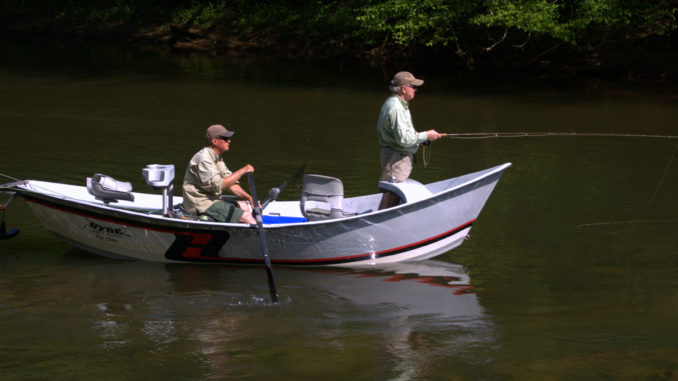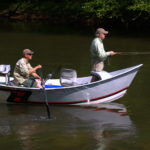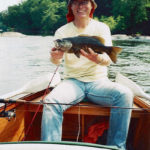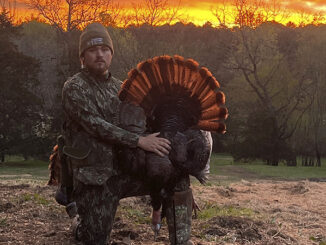
Use of drift boats increasing on WNC streams
On weekends, and some weekdays, it’s not uncommon to see four or five drift boats on the delayed-harvest section of the Tuckasegee River in Jackson County. Fishing guides and clients alike prefer the boats because they can cover a lot more water by boat than by wading. Plus, fishing from a boat is a lot easier than trying to walk over slippery rocks and wade through strong currents.
More and more trout guides are using drift boats to fish the larger streams in western North Carolina and eastern Tennessee. The boat’s rocker-style hull is designed for shallow-water displacement, making it an ideal craft for rocky, whitewater streams. Patterned after the McKenzie Drift Boat originated by Tom Kaarhus of Eugene, Ore., drift boats began showing up on North Carolina streams in the early 1990s.
One of the first people in western North Carolina to use a drift boat was Bob Dalley of Lake Junaluska, a retired industrial engineering professor at Western Carolina University in Cullowhee.
An avid fisher, Dalley had fished area streams in a variety of water craft (rubber rafts, canoes, johnboats), most of which be built himself. The boats were serviceable, but not what Dalley considered ideal for fishing mountain streams.
At a fishing show in Townsend, Tenn., Dalley saw his first McKenzie boat.
“It took my breath away,” he said. “I had to have one.”
Dalley studied the boat’s simple yet efficient design and decided he could build one himself. After purchasing 15-foot strips of marine plywood, he began building his boat, modifying it for a frameless design with an interior rather than an exterior keel. This construction method enabled Dalley to cut out and assemble the hull in one 14-hour day.
“It took me about two weeks to finish it,” he said.
The interior-keel design, Dalley said, keeps it from getting hung up on rocks. The keel modification did not affect the boat’s sturdiness.
While some drift boats are motorized, true McKenzie-style boats are propelled with 8- or 12-foot oars using a technique called ferrying. The boat’s unique design, Dalley said, gives it exceptional maneuverability and stability. It also can be anchored in rapids much more easily than traditional boats, an especially attractive feature for float fishing.
Although some McKenzie boats are constructed of aluminum and fiberglass, Dalley chose wood because of its buoyancy and because “wood is a lot quieter in the water.”
Dalley’s first boat had vinyl strips glued along the edges to protect the hull, and the bottom was coated with a combination of graphite and Kevlar (the material used to make bullet-proof vests). The boat he built was 15 feet long, with a 5-foot beam and 14-inch rocker.
Dalley tested the boat on Lake Junaluska.
“People were stopping all along the road to look at it,” he said.
For a true test run, he and a colleague took the McKenzie boat to the Nantahala River, considered the Southeast’s premier whitewater stream.
“We had 3-foot waves, but the boat handled exceptionally well,” Dalley said. “We got stuck on rocks once, but when we both moved forward a little, it slipped easily off the rocks because of the graphite on the bottom.”
After the initial run, Dalley took the boat to the French Broad River in Buncombe County to fish for smallmouth bass. The boat performed without a hitch.
“From the airport through the Biltmore Estate is a really a fine section for smallmouth,” Dalley said, showing a photograph of a 4-pound smallmouth.
While the price of a McKenzie boat can run $3,000 and up, Dalley said the materials to build his drift boat cost $400, exclusive of the 12-foot oars he purchased from a manufacturer.
Because rowing is a learned skill, Dalley said learning to maneuver a McKenzie boat takes practice. You have to be able to read a stream and work with currents. Everything is done with backstrokes, he said. The rower and bow of the boat face downstream, and the rower must develop the habit of backstroking to maneuver and avoid obstacles. Backstrokes are much more effective than forward strokes because they utilize the energy of the arms, back, and legs.
When an obstacle such as a boulder or log is encountered, the backstroke pushes the boat back, preventing it from driving into the hazard, as a forward stroke is more likely to do. The backstroke also keeps the boat placed in position longer for anglers attempting to work a section of water thoroughly.
According to records, Kaarhus built the first drift boat in 1910 to fish the McKenzie River near his home. His boat was smaller, lighter, and easier to handle than the 20-foot scows that were commonly used on rivers in Oregon and other western states. His design was modified in the 1940s by Woodie Hindman of Springfield, Ore. His design gave the boat a bowed look, much like the rockers on a rocking chair. Later, Hindman added a transom so that a small motor could be attached.
The standard drift boat can hold three people — a fisher fore and aft and the guide in the middle doing the rowing. The guide does all the work, and the clients concentrate on enjoying the fishing.







Be the first to comment